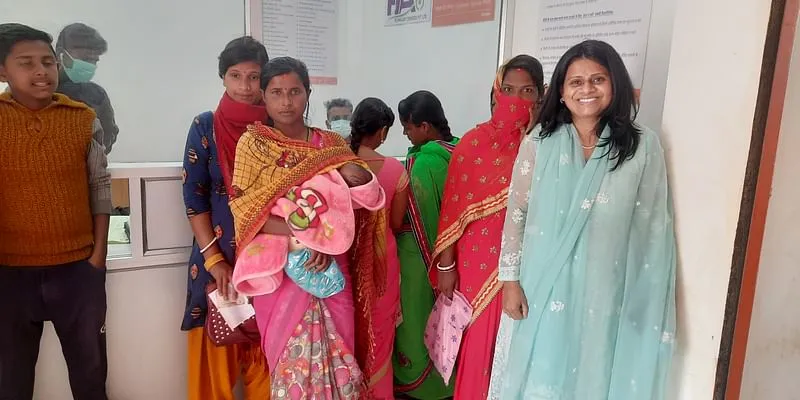Why this MIT graduate is building a digital banking platform for the poor
Seema Prem launched FIA Global, which works on assisted banking services and partners with financial institutions, to set up banking outlets across the country.
Seema Prem was born into an Army family, and having spent her childhood in some of the remotest corners of India, she grew up determined to work towards reducing the inequalities she witnessed while moving around.
After completing her engineering and business degrees, in her first job, Seema was part of a team that launched mobile services in South India, and she still delights in recalling that the first mobile call happened in her hands around the late 90s.
Later, a desire to solve some of the world’s most pressing challenges prompted her to pursue a fellowship from Massachusetts Institute of Technology (MIT), USA. Working on a financial exclusion project at MIT, the sheer opportunity for transformation presented itself.
During her project, Seema learnt that more than 50 percent of the world’s population is unbanked, confirming that the financial inclusion space was a huge untapped opportunity. She decided to leverage her experience in mobile services to address this issue, and pitched forth a business idea at the MIT100K entrepreneurship contest. Run by the institute, the competition is a series of distinct, increasingly intensive contests that students and researchers from across MIT and Greater Boston region attend to launch their talent, and ideas.
Seema won the Runners Up position in the contest, and this led to the birth of Gurugram-based banking services firm in 2012. Initially, Seema co-founded the company along with Sameer Mathur, who was also in MIT, however, Sameer is no longer part of the organisation.

Seema Prem
FIA works on assisted banking services, and partners with financial institutions to set up banking outlets across the country, which are manned by micro-entrepreneurs from the local community who are appointed by FIA after a rigorous vetting process.
What do these outlets do?
Functioning as a mini bank branch, the FIA outlets, also known as (aka) Customer Service Points (CSP), are equipped with a laptop, a biometric device and a printer. Through internet connectivity, the CSPs are connected real-time with the bank’s core banking solution and operated by a bank mitra, aka as business correspondent or bank agent.
It is here at the CSPs that the unbanked can walk in and conduct basic financial transactions in real-time. Since it is biometric-enabled, it is also completely secure. Before starting any banking operation, the banking agent is given a digital wallet which he must fund. While collecting deposits from customers, the amount is deducted from the agent’s wallet, and when it reaches 0, the agent cannot collect any more deposits. Similarly, the wallet amount increases with
cash given to customers.
“Given the rapidly changing customer behaviour towards owning their financial transactions, which has been spurred by the pandemic, FIA is building a mobile banking platform called FINTAP, which will aggregate more than 20+ financial services,” says Seema.
According to her, the products are complex in nature and are difficult to be understood or adopted in its current form by its customer segment – poorly educated, low-income folks with limited mobility.
“We first work on redesigning the product to make it bite-sized. These are then offered in an automated and paperless manner, often in simple 123 clicks to ensure faster adoption. For instance, our customers save too much and invest very little leading to negative real returns. They either save in fixed deposits or in illiquid financial instruments like real estate and gold. We worked with one fund house to redesign mutual funds keeping the needs of the poor – tiny instalments as low as Rs 100, variable instalments depending on their cash flows and paperless enrolment,” says Seema.
Pandemic and growth
During the pandemic, FIA centres were essential links that continued to provide uninterrupted banking services, and banked more than 2 million people (mostly women), disseminated vital covid information to 30,000+ villages and distributed $20 million in covid cash relief to people who needed it the most.
Which explains why the company managed to successfully deliver on all outcomes and impact parameters, and reportedly remained profitable despite the challenges and lockdowns that ensued due to Covid.
“Close to 45 million people banked with us, of which more than 50 percent were women. For FIA customers, it is not just a number, but it’s a way out of poverty. It is about financial empowerment, and security. The crisis has validated the strength of our business model and its resilience under the pressure of a global pandemic,” says Seema.
The initial months of the pandemic saw many women pushed out of the workforce, and Seema says FIA is now actively working to increase the number of women entrepreneurs as banking agents. “The company also provides targeted lending solutions for women-led micro-enterprises,” adds Seema. Today, FIA is a team of over 200 employees.
At the helm
Besides Seema, FIA’s core team comprises of Biju Balakrishnan, the Chief Technology Officer (CTO), Deb Shanker Mukhopadhyay, the Chief Strategy Officer, and Rahul Yajnik, who leads Sales.
“In the early stages of our growth, we received two grants of $350K each from World Bank and the Millennium Alliance. This helped us to rapidly scale our business and reach a certain size, which ensured ongoing sustainability. FIA’s roadmap includes transitioning from assisted banking to directly owning the last mile customer, setting up operations in Bangladesh and starting our lending operations to fill a critical financing gap for women led enterprises. For this, we will be raising funds in the short-term,” claims Seema.
As for competition, there are other startups like Arth in this space. As of last year, Arth had supported micro-entrepreneurs with capital for their multiple needs. It has over 3.5 lakh unique customers in more than 18,400 pincodes.
FIA’s main revenue source is the fees it receives from the banking partners for every transaction conducted in the outlets. There is a one-time enrolment fee and then a chargeable fee for every transaction. The financial institution partners also offset the marketing costs for conducting financial literacy and product training programs.
“Our centres are in underserved areas, which give us near exclusivity. This ensures consistent footfalls at our centres ensuring steady, recurring revenue. Our vast distribution network and growing customer base make us very attractive to new financial service providers. This enables us to pump new products through our network, and since our customer acquisition costs increase only marginally, it results in greater efficiency and better profits. Our existing banking partners also see us as a strategic, outsourced extension of their operations, and they enter into multiple agreements which ensure growing revenues, sticky relationships and brand loyalty,” says Seema.
Besides revenue from the banking partners, FIA also charges a one-time subscription fee from agents for using the platform. The team refused to share the fee and charge amount.
Future plans
Seema is firm that FIA’s fintech journey is also about integrating the power of AI & machine learning to create financially independent and empowered individuals.
According to her, although there are over 1 billion banking accounts, more than 85 percent of the accounts are used for just cash transactions. Also, Indians save too much and invest too little - which essentially gives negative real returns.
The unbanked population in India also suffer from sub-optimal asset allocation - livestock, gold, real estate, and less than 1 percent invest in capital markets. Also, out of pocket health care expenses push more than 100 million folk s into poverty every year due to lack of health cover, shares Seema.
“FIA plans to address this gap by creating the largest digital platform for the poor. FINTAP is a technology solution that will offer all financial services under one platform, addressing all financial needs of the poor - basic banking services, conducting digital transactions, job creation through lending solutions, wealth creation and protection through investments and insurance. Our goal is to create one million jobs, over $10 billion in savings, and over 100 million customers,” says Seema. What remains to be seen is if the company’s feet on the street approach will lead it to these numbers.
Edited by Anju Narayanan




![[HS Exclusive] How NagaEd became the first Nagaland startup to attract FDI](https://images.yourstory.com/cs/4/0911f29093a911ec98ee9fbd8fa414a8/ImageTaggingPooja9-1649704738696.jpg?fm=png&auto=format&h=100&w=100&crop=entropy&fit=crop)





